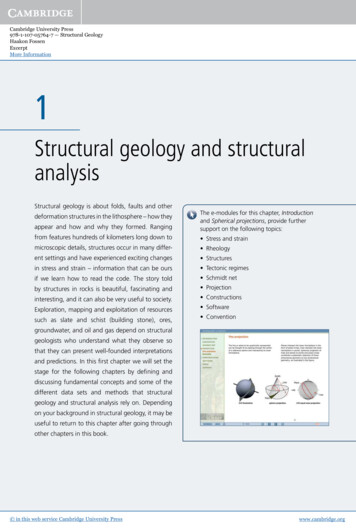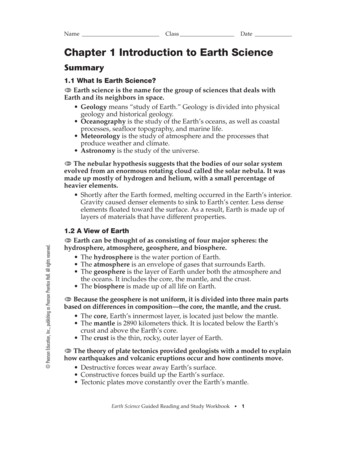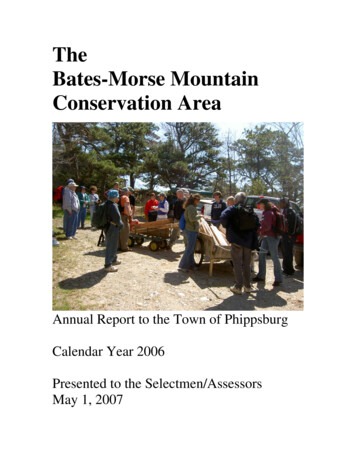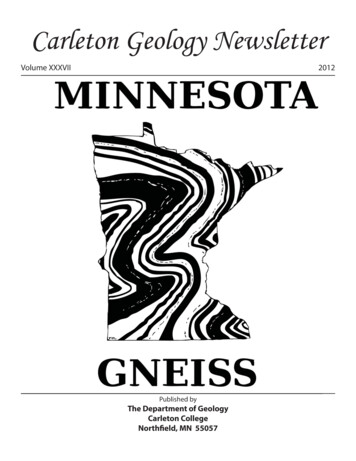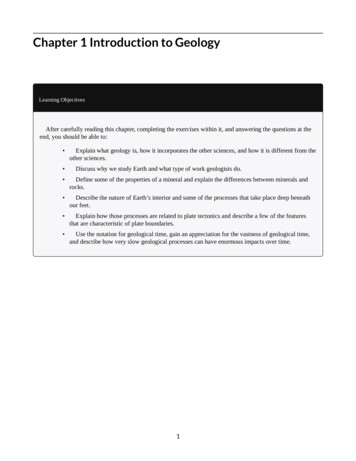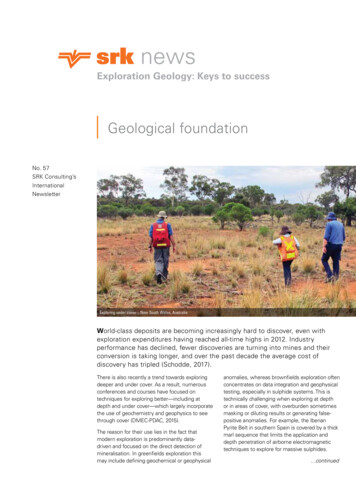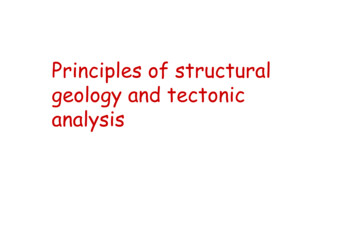
Transcription
Principles of structuralgeology and tectonicanalysis
Strain In response to stress, rocks undergotransformations that are decomposed in 3operations:– Rotation– Translation– Deformation which corresponds to a change inform Strain is a change in shape or internalconfiguration of a body
Strain Strain is marked by– Transformation of an initial circle/sphere intoan ellipse/ellipsoid The axis of deformation– Movement of particules defined by aninstantaneous velocity vector, defining flowlines and finally trajectories The kinematic notion, a function of time
Stress and strain– Rheology is the study of the relationships betweenstress imposed on a body and resulting strains orstrain rates– Competence is a general term to describe the easewith which a material can deform– In response to a stress, strain may be Reversible, elastic deformation Brittle, failure of a stressed body, at a certainstate, the solid rocks lose their internalcohesion Permanent, ductile flow without brittledeformation
3 axis of deformation, a finite strain ellipsoid–Principal– strain directions, X, Y, Z– planes XY, YZ, ZX– changes in length e1, e2, e3– ratios Rxy, Ryz, Rzx
The Flinn graph for representing theshape of any ellipsoidX/YY/ZRamsay & Huber, Academic Press Lim., 1983
Strain regimes Deformation in rocks occurs under 2 strainregimes:– Pure shear– Simple shear Under combination of pure and simpleshear
Simple shear A displacement which transforms an initialsquare in a parallelogram where thedisplacement vectors are all orientedparallel to one set of the opposite sides ofthe square and parallelogram. The vectordirection is know as the shear direction.
Transformation of a sphere in anellispoid, 2 strain regimes/Z/XPure shearSimple shearChoukroune, Masson, 1995
2 end-membersPure shearAxis of deformationremains parallel (coaxialand non rotational)Flow lines tends tobecome perpendicular tothe Z shortening axisDeformation DisplacementSimple shearAxis of deformationrotate (non coaxial androtational)Flow lines are parallel tothe shear direction duringthe deformationDeformation Displacement
Finite strain ellipsoid and strain regimesChoukroune, Masson, 1995
The Flinn graph for representing theshape of any ellipsoidX/YY/ZRamsay & Huber, Academic Press Lim., 1983
Change in geometry from coaxial to noncoaxial regimesCoaxialNon coaxial
Markers of the finite strain ellipsoid Fold and boudinage structures– Boudinage is a structure produced during heextension of competent layers enclosed in anincompetent matrix
Deflection of cleavage around a competentfragment of quartzite in an argiliteRamsay & Huber, Academic Press Lim., 1983
Folding and boudinage in a Flinn graphFLATTENING
Markers of the finite strain ellipsoid Deformation of pre-tectonic objects pebble, phenocryst, oolithe, redox spot,fossil. Mineral fabric and pressure shadows Fabric is the geometric and spatialrelationships between the crystalcomponents making a rock, i.e. preferredorientation of grain shapes andcrystallographic axis, the grain size Pressure shadow is a region of low strainprotected from deformation by a rigid orcompetent object in a rock of lowercompetence
Pressure shadows in a Flinn graphL SL SS L
A linear type fabric: L S from theHakos mountainsA granitic orthogneiss
A linear type fabric: L S from theHakos mountainsA metaconglomerate
ShearedGamsberggraniteXZ plane1 single rock!YZ plane
ShearedrhyoliteXZ plane1 single rock !YZ plane
Partitioning and time Homogeneous vs non homogeneous deformation The definition of zones of homogeneousdeformation The notion of bulk strain, an average strain in aheterogeneously deformed material Finite strain vs incremental deformation, notionof progressive deformation Increment from one stage to the next Rate of change along the main strain axis and ofrotation defines the principal strain rates and thevorticity Definition of the strain regime by identificationand analysis of the markers of incrementaldeformation
Pure shear and development ofstructural elements Crenulation and mechanical rotationPressure-solution, a deformation processwhereby material under stress goes intosolution at a localized point in a material,this material is transported by flow ordiffusionRecrystallisationTransposition
Pure shear and development of folds ,axial plane cleavage.
Pure shear and development of folds,axial plane cleavage.
Progressive stages in fabricdevelopment of a shale Initial compactedEaliest deformationPencil structureEmbryonnic deformationplanedeformation planedeformation plane withstretching lineationType of linear fabricCDE F
Simple shear and development of shearzone A shear zone is a zone with sub-parallelwalls in which high deformations arelocalized Effects of non coaxial deformation Plane strain ellipsoid Markers of rotational deformation– Coexistence of deformation and displacementplanes, S/C/C’ structures– Assymetric pressure shadows and mineralfabric– Folding
S C C ’ structures The S plane: the deformation plane, with no displacement The C and C ’ planes: the displacement planes with highdeformation (mylonitisation)CSSCCC//SC’C’
CSCSS C C ’ structures: aprogressive phenomenonCt1Ct2C//St3C’C’
SS C C ’ structuresC’CSC
Assymetric pressure shadowCC
Assymetric pressure shadow
Cleavage bendingand heliciticinclusions
Assymetric foldsand pressureshadows
Fabric in a ductile simple shear zone
A reverse shear zone within the basementinlier of the Damara forelandCSheared porphyric graniteC’S//CSL downdip tectonite
Development of non cylindrical foldsduring non coaxial deformation
Development of non cylindrical foldsduring non coaxial deformation
Development of non cylindrical foldsduring non coaxial deformation
Progressive developement of sheathfolds
Sheath folds fromthe Ile de Groix
Sheath folds from the base of a thrustnappe from the Variscan belt of France
Sheath folds from the base of a thrustnappe from the Hakos mountains
Shear zones and shear zones Geometry of the shear zonesdeveloped in flatteningor constriction fieldGapais et al., Journ. Struct. Geol, 7, 1987
Change in geometry from coaxial to noncoaxial regimesCoaxialNon coaxial
Conjugate shear zones: a coaxial regimeNNWSSESCSC
vs a non coaxial regime.CC’S//CS
Principles of structural geology and tectonic analysis. Strain In response to stress, rocks undergo transformations that are decomposed in 3 operations: - Rotation -Translation - Deformation which corresponds to a change in form Strain is a change in shape or internal
